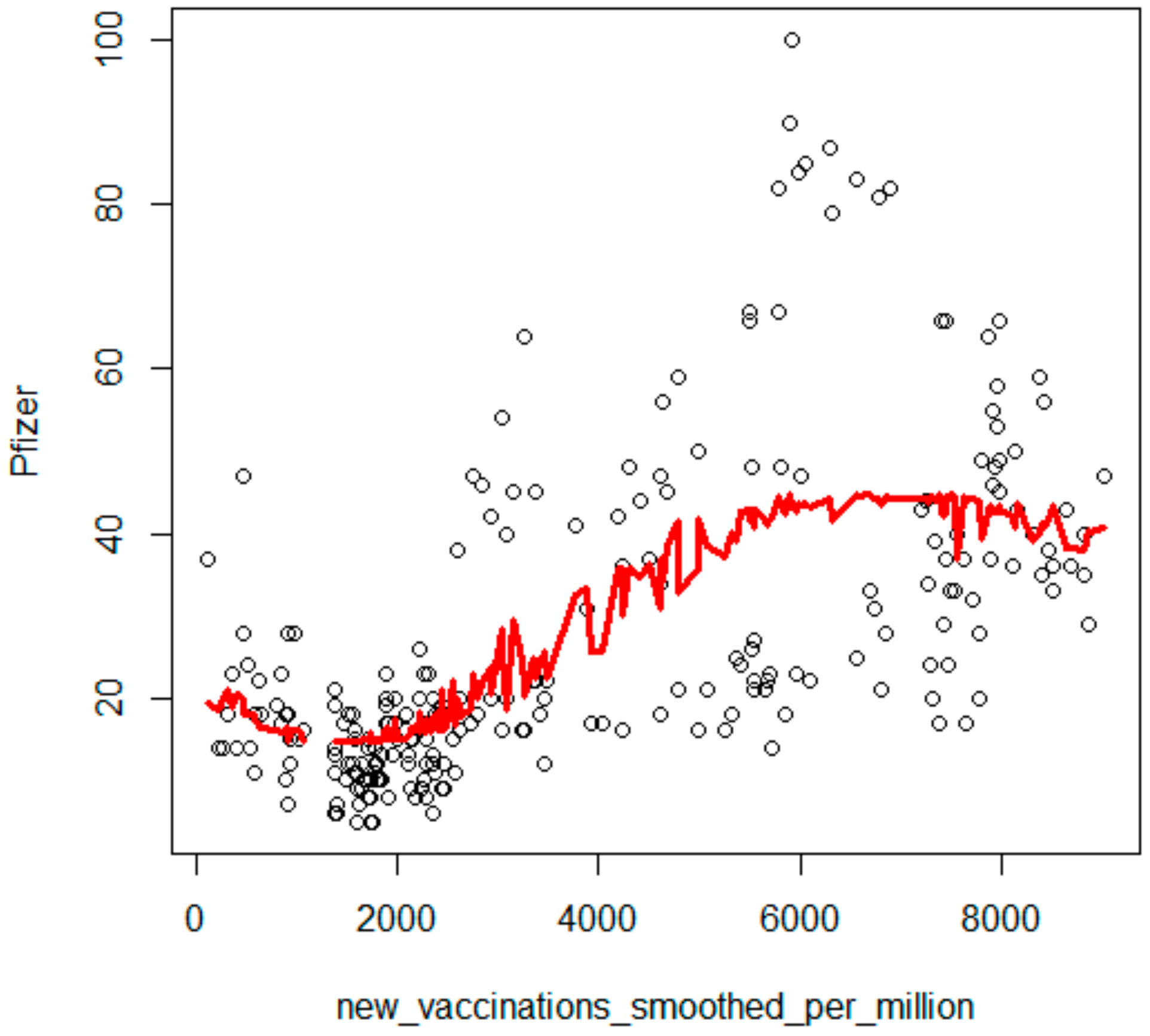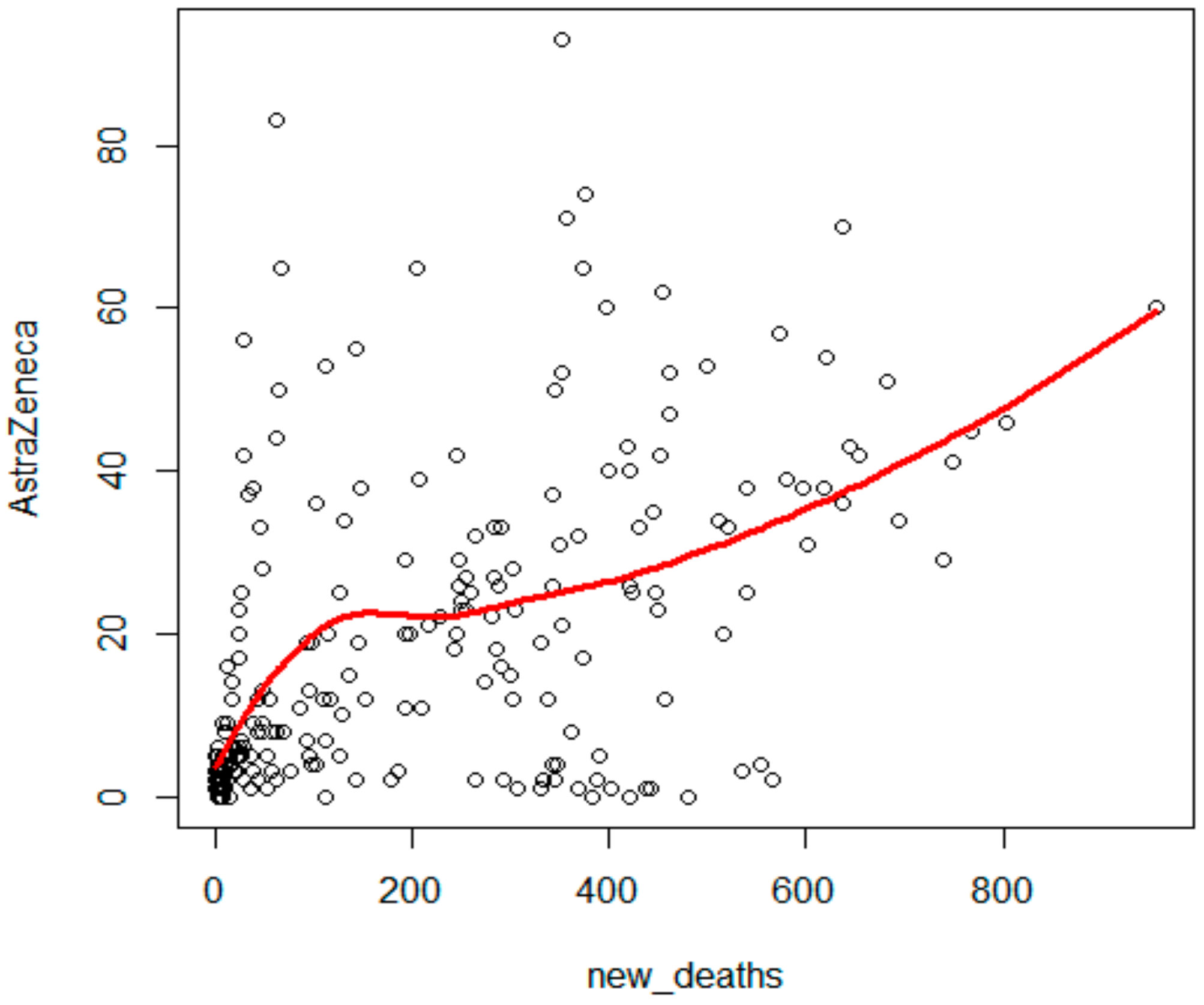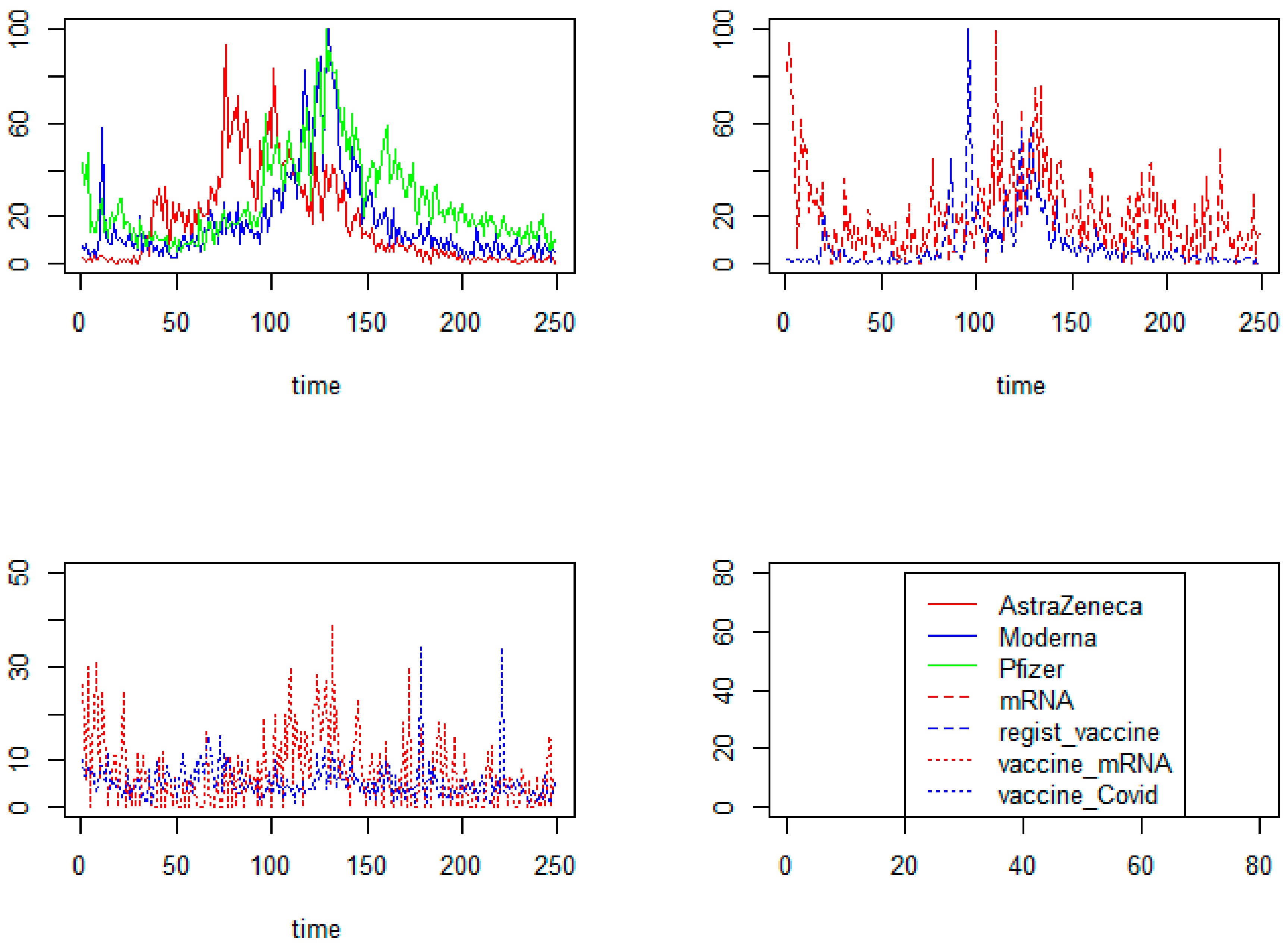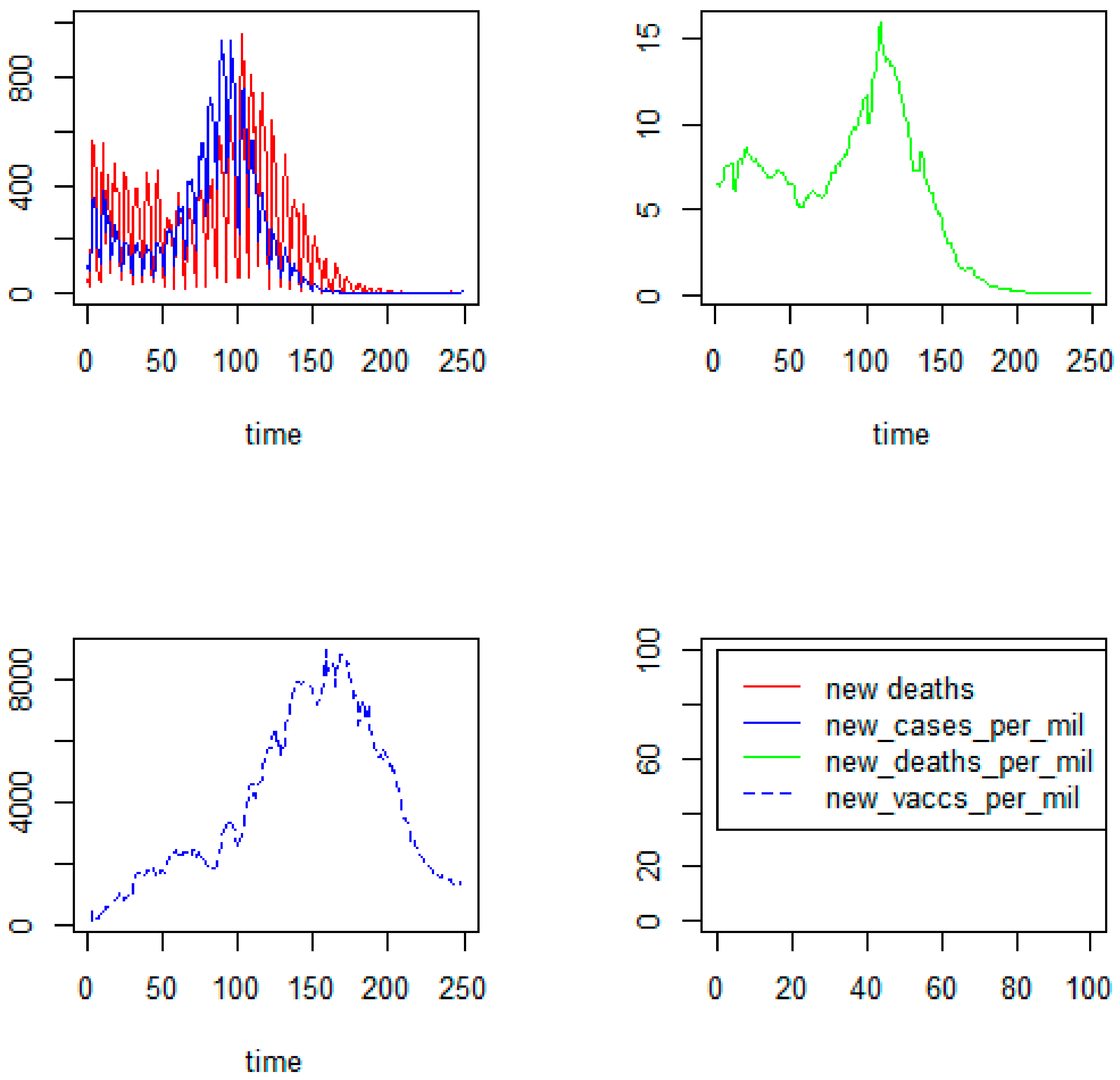The Relationship between Searches for COVID-19 Vaccines and Dynamics of Vaccinated People in Poland: An Infodemiological Study
Abstract
:1. Introduction
- To show dependencies among the frequency of searches for COVID-19 vaccines and the number of vaccinated people in Poland;
- To show dependencies among the frequency of searches for COVID-19 vaccines and epidemiological data on SARS-CoV-2, i.e., the number of new cases and new deaths;
- To characterise the online interest in COVID-19 vaccines over a time basis.
2. Materials and Methods
2.1. Google Trends Data
2.2. Epidemiological Data of COVID-19
2.3. Statistical Analysis
3. Results
3.1. The Frequency of Searches for COVID-19 Vaccines vs. the Number of Vaccinated People
3.2. The Frequency of Searches for COVID-19 Vaccinations vs. Epidemiological Data
3.3. The Characteristics of Online Interest in COVID-19 Vaccinations over a Time Basis
3.4. The Characteristics of Epidemiological Data over a Time Basis
4. Discussion
5. Conclusions
Supplementary Materials
Author Contributions
Funding
Institutional Review Board Statement
Informed Consent Statement
Data Availability Statement
Acknowledgments
Conflicts of Interest
References
- Eysenbach, G. How to Fight an Infodemic: The Four Pillars of Infodemic Management. J. Med. Internet Res. 2020, 22, e21820. [Google Scholar] [CrossRef] [PubMed]
- Eysenbach, G. Infodemiology: Tracking Flu-Related Searches on the Web for Syndromic Surveillance. AMIA Annu. Symp. Proc. 2006, 2006, 244–248. [Google Scholar]
- Eysenbach, G. Infodemiology and Infoveillance: Framework for an Emerging Set of Public Health Informatics Methods to Analyze Search, Communication and Publication Behavior on the Internet. J. Med. Internet Res. 2009, 11, e11. [Google Scholar] [CrossRef] [PubMed]
- World Health Organizations. Novel Coronavirus(2019-nCoV) Situation Report—13; World Health Organization: Geneva, Switzerland, 2 February 2020; Available online: https://www.who.int/docs/default-source/coronaviruse/situation-reports/20200202-sitrep-13-ncov-v3.pdf (accessed on 27 June 2022).
- Serwis Rzeczypospolitej Polskiej. Available online: https://www.gov.pl/web/szczepimysie/narodowy-program-szczepien-przeciw-covid-19 (accessed on 27 June 2022).
- Wawrzuta, D.; Jaworski, M.; Gotlib, J.; Panczyk, M. Characteristics of Antivaccine Messages on Social Media: Systematic Review. J. Med. Internet Res. 2021, 23, e24564. [Google Scholar] [CrossRef] [PubMed]
- Nr-33; Research Report: Attitude to COVID-19 Vaccinations in March. Public Opinion Research Center: Warsaw, Poland, 2021.
- Kłak, A.; Grygielska, J.; Mańczak, M.; Ejchman-Pac, E.; Owoc, J.; Religioni, U.; Olszewski, R. Online Information of COVID-19: Visibility and Characterization of Highest Positioned Websites by Google between March and April 2020—A Cross-Country Analysis. Int. J. Environ. Res. Public Health 2022, 19, 1491. [Google Scholar] [CrossRef]
- Serwis Rzeczypospolitej Polskiej. Available online: https://www.gov.pl/web/loteria/zasady-i-regulamin2 (accessed on 27 June 2022).
- World Health Organization. Tracking SARS-CoV-2 Variants. Available online: https://www.who.int/en/activities/tracking-SARS-CoV-2-variants/ (accessed on 27 June 2022).
- Bentley, R.A.; Ormerod, P. Social versus independent interest in ‘bird flu’ and ‘swine flu’. PLoS Curr. 2009, 1, RRN1036. [Google Scholar] [CrossRef]
- Carneiro, H.A.; Mylonakis, E. Google trends: A web-based tool for real-time surveillance of disease outbreaks. Clin. Infect. Dis. 2009, 49, 1557–1564. [Google Scholar] [CrossRef] [Green Version]
- Pelat, C.; Turbelin, C.; Bar-Hen, A.; Flahault, A.; Valleron, A. More diseases tracked by using Google Trends. Emerg. Infect. Dis. 2009, 15, 1327–1328. [Google Scholar] [CrossRef]
- Mavragani, A.; Ochoa, G.; Tsagarakis, K.P. Assessing the Methods, Tools, and Statistical Approaches in Google Trends Research: Systematic Review. J. Med. Internet Res. 2018, 20, e270. [Google Scholar] [CrossRef] [Green Version]
- Anema, A.; Kluberg, S.; Wilson, K.; Hogg, R.S.; Khan, K.; Hay, S.I.; Tatem, A.J.; Brownstein, J.S. Digital surveillance for enhanced detection and response to outbreaks. Lancet Infect. Dis. 2014, 14, 1035–1037. [Google Scholar] [CrossRef] [Green Version]
- Bragazzi, N.L.; Alicino, C.; Trucchi, C.; Paganino, C.; Barberis, I.; Martini, M.; Sticchi, L.; Trinka, E.; Brigo, F.; Ansaldi, F.; et al. Global reaction to the recent outbreaks of Zika virus: Insights from a Big Data analysis. PLoS ONE 2017, 12, e0185263. [Google Scholar] [CrossRef]
- Guo, P.; Zhang, J.; Wang, L.; Yang, S.; Luo, G.; Deng, C.; Wen, Y.; Zhang, Q. Monitoring seasonal influenza epidemics by using internet search data with an ensemble penalized regression model. Sci. Rep. 2017, 7, 46469. [Google Scholar] [CrossRef]
- Bo, A.; Friis, K.; Osborne, R.H.; Maindal, H.T. National indicators of health literacy: Ability to understand health information and to engage actively with healthcare providers—A population-based survey among Danish adults. BMC Public Health 2014, 14, 1095. [Google Scholar] [CrossRef] [Green Version]
- Sørensen, K.; Pelikan, J.M.; Röthlin, F.; Ganahl, K.; Slonska, Z.; Doyle, G.; Fullam, J.; Kondilis, B.; Agrafiotis, D.; Uiters, E.; et al. Health Literacy in Europe: Comparative results of the European Health Literacy survey (HLS-EU). Eur. J. Public Health 2015, 25, 1053–1058. [Google Scholar] [CrossRef] [Green Version]
- Benchimol, E.I.; Smeeth, L.; Guttmann, A.; Harron, K.; Moher, D.; Petersen, I.; Sørensen, H.T.; von Elm, E.; Langan, S.M.; Committee, R.W. The REporting of studies Conducted using Observational Routinely-collected health Data (RECORD) statement. PLoS Med. 2015, 12, e1001885. [Google Scholar] [CrossRef]
- Datareportal. Digital 2021: Poland. Available online: https://datareportal.com/reports/digital-2021-poland (accessed on 22 July 2022).
- Bujnowska-Fedak, M.M. Trends in the use of the Internet for health purposes in Poland. BMC Public Health 2015, 15, 194. [Google Scholar] [CrossRef] [Green Version]
- Statista. Leading Internet Search Engines in Poland in March 2022. Available online: https://www.statista.com/statistics/1086209/poland-leading-search-engines/ (accessed on 22 July 2022).
- An, L.; Russell, D.M.; Mihalcea, R.; Bacon, E.; Huffman, S.; Resnicow, K. Online Search Behavior Related to COVID-19 Vaccines: Infodemiology Study. JMIR Infodemiol. 2021, 1, e32127. [Google Scholar] [CrossRef]
- Sousa-Pinto, B.; Anto, A.; Czarlewski, W.; Anto, J.M.; Fonseca, J.A.; Bousquet, J. Assessment of the impact of media coverage on COVID-19-related Google Trends data: Infodemiology study. J. Med. Internet Res. 2020, 22, e19611. [Google Scholar] [CrossRef]
- Mangono, T.; Smittenaar, P.; Caplan, Y.; Huang, V.S.; Sutermaster, S.; Kemp, H.; Sgaiser, S.K. Information-seeking patterns during the COVID-19 pandemic across the United States: Longitudinal analysis of google trends data. J. Med. Internet Res. 2021, 23, e22933. [Google Scholar] [CrossRef]
- Vismara, M.; Vitella, D.; Biolcati, R.; Ambrosini, F.; Pirola, V.; Dell’Osso, B.; Truzoli, R. The Impact of COVID-19 Pandemic on Searching for Health-Related Information and Cyberchondria on the General Population in Italy. Front. Psychiatry 2021, 12, 754870. [Google Scholar] [CrossRef]
- Powiatowa Stacja Sanitarno-Epidemiologiczna w Aleksandrowie Kujawskim, Polska ma Zapewnione 85 mln Dawek Szczepionki. Available online: https://www.gov.pl/web/psse-aleksandrow-kujawski/polska-ma-zapewnione-85-mln-dawek-szczepionki (accessed on 22 July 2022).
- Serwis Rzeczypospolitej Polskiej. Raport ze Szczepień (18 Stycznia 2021 r.). Available online: https://www.gov.pl/web/szczepimysie/raport-ze-szczepien-18-stycznia-2021-r (accessed on 22 July 2022).
- Shields, M.; Burger, L. Austria Suspends AstraZeneca COVID-19 Vaccine Batch after Death. REUTERS. 7.03.2021. Available online: https://www.reuters.com/article/us-health-coronavirus-austria-nurse-idUKKBN2AZ0AO (accessed on 7 August 2022).
- Medonet. Gdzie Wstrzymano Szczepienia AstraZenecą? 16 March 2021. Available online: https://www.medonet.pl/porozmawiajmyoszczepionce/szczepionka-na-covid-19,gdzie-wstrzymano-szczepienia-astrazeneca---lista-krajow-,artykul,54602188.html (accessed on 7 August 2022).
- Escritt, T.; Nebehay, S. Germany, Italy, France Suspend AstraZeneca Shots Amid Safety Fears, Disrupting EU Vaccinations. Reuters. 15 March 2021. Available online: https://www.reuters.com/article/us-health-coronavirus-idUSKBN2B722U (accessed on 7 August 2022).
- Serwis Rzeczypospolitej Polskiej. Wcześniejsze Terminy Szczepień. Osoby 60+ Mogą Zaszczepić Się w Kwietniu. 6 April 2021. Available online: https://www.gov.pl/web/szczepimysie/wczesniejsze-terminy-szczepien-osoby-60-plus-moga-zaszczepic-sie-w-kwietniu (accessed on 7 August 2022).
- Venkatesh, U.; Gandhi, P.A. Prediction of COVID-19 Outbreaks Using Google Trends in India: A Retrospective Analysis. Healthc. Inform. Res. 2020, 26, 175–184. [Google Scholar] [CrossRef]
- Ciaffi, J.; Meliconi, R.; Landini, M.P.; Ursini, F. Google trends and COVID-19 in Italy: Could we brace for impact? Intern. Emerg. Med. 2020, 15, 1555–1559. [Google Scholar] [CrossRef]
- Rovetta, A.; Castaldo, L. A new infodemiological approach through Google Trends: Longitudinal analysis of COVID-19 scientific and infodemic names in Italy. BMC Med. Res. Methodol. 2022, 22, 33. [Google Scholar] [CrossRef]
- Lekkas, D.; Gyorda, J.A.; Price, G.D.; Wortzman, Z.; Jacobson, N.C. Using the COVID-19 Pandemic to Assess the Influence of News Affect on Online Mental Health-Related Search Behavior Across the United States: Integrated Sentiment Analysis and the Circumplex Model of Affect. J. Med. Internet Res. 2022, 24, e32731. [Google Scholar] [CrossRef]
- Ortiz-Martínez, Y.; Garcia-Robledo, J.E.; Vásquez-Castañeda, D.L.; Bonilla-Aldana, D.K.; Rodriguez-Morales, A.J. Can Google® trends predict COVID-19 incidence and help preparedness? The situation in Colombia. Travel Med. Infect. Dis. 2020, 37, 101703. [Google Scholar] [CrossRef]
- Donar, G.B.; Aydan, S. Association of COVID-19 with lifestyle behaviours and socio-economic variables in Turkey: An analysis of Google Trends. Int. J. Health Plann. Manag. 2022, 37, 281–300. [Google Scholar] [CrossRef]
- Paguio, J.A.; Yao, J.S.; Dee, E.C. Silver lining of COVID-19: Heightened global interest in pneumococcal and influenza vaccines, an infodemiology study. Vaccine 2020, 38, 5430–5435. [Google Scholar] [CrossRef] [PubMed]
- Maugeri, A.; Barchitta, M.; Agodi, A. Using Google Trends to Predict COVID-19 Vaccinations and Monitor Search Behaviours about Vaccines: A Retrospective Analysis of Italian Data. Vaccines 2022, 10, 119. [Google Scholar] [CrossRef] [PubMed]
- Awijen, H.; Zaied, Y.B.; Nguyen, D.K. Covid-19 vaccination, fear and anxiety: Evidence from Google search trends. Soc. Sci. Med. 2022, 297, 114820. [Google Scholar] [CrossRef] [PubMed]
- Pullan, S.; Dey, M. Vaccine hesitancy and anti-vaccination in the time of COVID-19: A Google Trends analysis. Vaccine 2021, 39, 1877–1881. [Google Scholar] [CrossRef]
- Berkman, N.D.; Davis, T.C.; McCormack, L. Health literacy: What is it? J. Health Commun. 2010, 15, 9–19. [Google Scholar] [CrossRef]






Publisher’s Note: MDPI stays neutral with regard to jurisdictional claims in published maps and institutional affiliations. |
© 2022 by the authors. Licensee MDPI, Basel, Switzerland. This article is an open access article distributed under the terms and conditions of the Creative Commons Attribution (CC BY) license (https://creativecommons.org/licenses/by/4.0/).
Share and Cite
Kłak, A.; Furmańczyk, K.; Nowicka, P.M.; Mańczak, M.; Barańska, A.; Religioni, U.; Siekierska, A.; Ambroziak, M.; Chłopek, M. The Relationship between Searches for COVID-19 Vaccines and Dynamics of Vaccinated People in Poland: An Infodemiological Study. Int. J. Environ. Res. Public Health 2022, 19, 13275. https://doi.org/10.3390/ijerph192013275
Kłak A, Furmańczyk K, Nowicka PM, Mańczak M, Barańska A, Religioni U, Siekierska A, Ambroziak M, Chłopek M. The Relationship between Searches for COVID-19 Vaccines and Dynamics of Vaccinated People in Poland: An Infodemiological Study. International Journal of Environmental Research and Public Health. 2022; 19(20):13275. https://doi.org/10.3390/ijerph192013275
Chicago/Turabian StyleKłak, Anna, Konrad Furmańczyk, Paulina Maria Nowicka, Małgorzata Mańczak, Agnieszka Barańska, Urszula Religioni, Anna Siekierska, Martyna Ambroziak, and Magdalena Chłopek. 2022. "The Relationship between Searches for COVID-19 Vaccines and Dynamics of Vaccinated People in Poland: An Infodemiological Study" International Journal of Environmental Research and Public Health 19, no. 20: 13275. https://doi.org/10.3390/ijerph192013275




